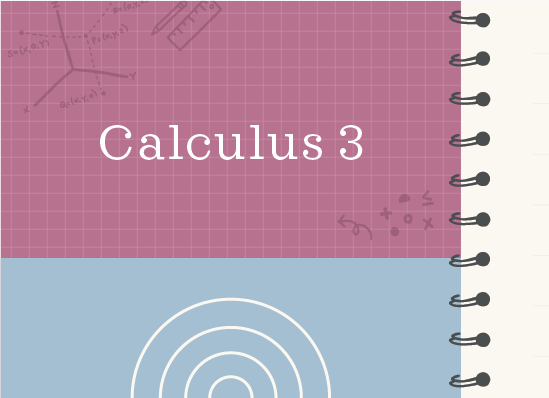Finding the equations of the normal and osculating planes
Formula for the equation of the osculating plane
Equation of the normal plane
To find the equation of the normal plane of a vector function ???r(t)=r(t)_1\bold i+r(t)_2\bold j+r(t)_3\bold k??? at some point ???P???, we’ll use the equation
???r'(t)_1(x-x_0)+r'(t)_2(y-y_0)+r'(t)_3(z-z_0)=0???
where ???x_0???, ???y_0??? and ???z_0??? come from the point ???P(x_0, y_0, z_0)???, and where ???r'(t)_1???, ???r'(t)_2??? and ???r'(t)_3??? come from the derivative of the vector function ???r'(t)=\langle r'(t)_1,r'(t)_2,r'(t)_3\rangle??? at ???t???.
Hi! I'm krista.
I create online courses to help you rock your math class. Read more.
In order to find a value for ???t???, we’ll need to compare the vector function ???r(t)??? to the point ???P???.
Equation of the osculating plane
If we want to find the equation of the osculating plane of the same vector function ???r(t)??? at the same point ???P???, we’ll use the equation
???B(t)_1(x-x_0)+B(t)_2(y-y_0)+B(t)_3(z-z_0)=0???
where ???x_0???, ???y_0??? and ???z_0??? come from the point ???P(x_0, y_0, z_0)???, and where ???B(t)_1???, ???B(t)_2??? and ???B(t)_3??? come from the binormal unit vector ???B(t)=\langle B(t)_1,B(t)_2,B(t)_3\rangle??? at ???t???.
In order to find a value for ???t???, we’ll need to compare the vector function ???r(t)??? to the point ???P???.
To get to the binormal unit vector, we’ll first have to find the unit tangent vector ???T(t)???, and the unit normal vector ???N(t)???.
The unit tangent vector ???T(t)??? is given by
???T(t)=\frac{r'(t)}{\left|r'(t)\right|}???
where ???r'(t)??? is the derivative of ???r(t)=r(t)_1\bold i+r(t)_2\bold j+r(t)_3\bold k???, and where ???\left|r'(t)\right|=\sqrt{\left[r'(t)_1\right]^2+\left[r'(t)_2\right]^2+\left[r'(t)_3\right]^2}???.
The unit normal vector ???N(t)??? is given by
???N(t)=\frac{T'(t)}{\left|T'(t)\right|}???
where ???T'(t)??? is the derivative of ???T(t)=T(t)_1\bold i+T(t)_2\bold j+T(t)_3\bold k??? and where ???\left|T'(t)\right|=\sqrt{\left[T'(t)_1\right]^2+\left[T'(t)_2\right]^2+\left[T'(t)_3\right]^2}???.
Then the binormal unit vector ???B(t)??? is given by
???B(t)=T(t)\times{N(t)}???
where ???T(t)\times{N(t)}??? is the cross product of the unit tangent and unit normal vectors.
Finding the equation of the osculating plane using the unit tangent and unit normal vectors in order to get the binormal vector
Take the course
Want to learn more about Calculus 3? I have a step-by-step course for that. :)
Step-by-step walkthrough of how to find the equation of the normal plane and equation of the osculating plane
Example
Find the equations of the normal and osculating planes of the vector function at ???P(1,1,0)???.
???r(t)=\cos{t}\bold i+\sin{t}\bold j+t\bold k???
We’ll need to find the following values, in this order:
The equation of the normal plane ???r'(t)_1(x-x_0)+r'(t)_2(y-y_0)+r'(t)_3(z-z_0)=0??? using
???t???
???r'(t)=\langle r'(t)_1,r'(t)_2,r'(t)_3\rangle???
The equation of the osculating plane ???B(t)_1(x-x_0)+B(t)_2(y-y_0)+B(t)_3(z-z_0)=0??? using
???\left|r'(t)\right|=\sqrt{\left[r'(t)_1\right]^2+\left[r'(t)_2\right]^2+\left[r'(t)_3\right]^2}???
???T(t)=\frac{r'(t)}{\left|r'(t)\right|}???
???T'(t)=\langle T'(t)_1,T'(t)_2,T'(t)_3\rangle???
???\left|T'(t)\right|=\sqrt{\left[T'(t)_1\right]^2+\left[T'(t)_2\right]^2+\left[T'(t)_3\right]^2}???
???N(t)=\frac{T'(t)}{\left|T'(t)\right|}???
???B(t)=T(t)\times{N(t)}???
Finding ???t???
Let’s start by finding a value for ???t???. Since the coefficient on ???\bold k??? is ???t??? itself, we can just take the value of ???z??? from the coordinate point and say that ???t=0???.
Finding ???r'(t)=\langle r'(t)_1,r'(t)_2,r'(t)_3\rangle???
Now we can move on to the equation of the normal plane. Our first step is to find the derivative of the vector function. In order to take the derivative of a vector function, we ignore ???\bold i???, ???\bold j??? and ???\bold k??? and just take the derivative of each of the coefficients.
???r(t)=\cos{t}\bold i+\sin{t}\bold j+t\bold k???
???r'(t)=-\sin{t}\bold i+\cos{t}\bold j+\bold k???
???r'(t)=\left\langle-\sin{t},\cos{t},1\right\rangle???
Since ???t=0???, the derivative becomes
???r'(0)=\left\langle-\sin{0},\cos{0},1\right\rangle???
???r'(0)=\left\langle0,1,1\right\rangle???
???r'(0)=0\bold i+1\bold j+1\bold k???
???r'(0)=\bold j+\bold k???
Finding the equation of the normal plane
Plugging in the values from the derivative and the point ???P(1,1,0)??? to the formula for the equation of the normal plane, we get
???r'(t)_1(x-x_0)+r'(t)_2(y-y_0)+r'(t)_3(z-z_0)=0???
???0(x-1)+1(y-1)+1(z-0)=0???
???(y-1)+z=0???
???y+z=1???
???y=1-z???
So the equation of the normal plane is ???y=1-z???.
Finding ???\left|r'(t)\right|=\sqrt{\left[r'(t)_1\right]^2+\left[r'(t)_2\right]^2+\left[r'(t)_3\right]^2}???
Now we’ll work on the equation of the osculating plane. Our first step is to find the unit tangent vector ???T(t)???, but since
???T(t)=\frac{r'(t)}{\left|r'(t)\right|}???
we’ll need to find the magnitude of the derivative first, so that we can plug it into the denominator. We already found ???r'(t)??? when we were working on the equation of the normal plane.
???\left|r'(t)\right|=\sqrt{\left[r'(t)_1\right]^2+\left[r'(t)_2\right]^2+\left[r'(t)_3\right]^2}???
???\left|r'(t)\right|=\sqrt{\left[-\sin{t}\right]^2+\left[\cos{t}\right]^2+[1]^2}???
???\left|r'(t)\right|=\sqrt{\sin^2{t}+\cos^2{t}+1}???
Given the trigonometric identity ???\sin^2{x}+\cos^2{x}=1???, we can say
???\left|r'(t)\right|=\sqrt{1+1}???
???\left|r'(t)\right|=\sqrt{2}???
Since there’s no ???t??? variable on the right side, evaluating the magnitude of the derivative at ???t=0??? doesn’t change its value, so
???\left|r'(0)\right|=\sqrt{2}???
Finding ???T(t)=\frac{r'(t)}{\left|r'(t)\right|}???
Therefore we can say that the unit tangent vector is
???T(t)=\frac{r'(t)}{\left|r'(t)\right|}???
???T(t)=\frac{-\sin{t}\bold i+\cos{t}\bold j+\bold k}{\sqrt2}???
???T(t)=-\frac{1}{\sqrt2}\sin{t}\bold i+\frac{1}{\sqrt2}\cos{t}\bold j+\frac{1}{\sqrt2}\bold k???
???T(t)=\frac{\sqrt2}{\sqrt2}\left(-\frac{1}{\sqrt2}\sin{t}\bold i+\frac{1}{\sqrt2}\cos{t}\bold j+\frac{1}{\sqrt2}\bold k\right)???
???T(t)=-\frac{\sqrt2}{2}\sin{t}\bold i+\frac{\sqrt2}{2}\cos{t}\bold j+\frac{\sqrt2}{2}\bold k???
???T(t)=\left\langle-\frac{\sqrt2}{2}\sin{t},\frac{\sqrt2}{2}\cos{t},\frac{\sqrt2}{2}\right\rangle???
Since ???t=0???, we get
???T(0)=\left\langle-\frac{\sqrt2}{2}\sin{0},\frac{\sqrt2}{2}\cos{0},\frac{\sqrt2}{2}\right\rangle???
???T(0)=\left\langle0,\frac{\sqrt2}{2},\frac{\sqrt2}{2}\right\rangle???
???T(0)=\frac{\sqrt2}{2}\bold j+\frac{\sqrt2}{2}\bold k???
Finding ???T'(t)=\langle T'(t)_1,T'(t)_2,T'(t)_3\rangle???
Our next step is to find the unit normal vector ???N(t)???, but since
???N(t)=\frac{T'(t)}{\left|T'(t)\right|}???
we’ll need to find the derivative of the unit tangent vector ???T'(t)??? and its magnitude first, so that we can plug them into the formula for the unit normal vector.
???T(t)=-\frac{\sqrt2}{2}\sin{t}\bold i+\frac{\sqrt2}{2}\cos{t}\bold j+\frac{\sqrt2}{2}\bold k???
???T'(t)=-\frac{\sqrt2}{2}\cos{t}\bold i-\frac{\sqrt2}{2}\sin{t}\bold j+0\bold k???
???T'(t)=-\frac{\sqrt2}{2}\cos{t}\bold i-\frac{\sqrt2}{2}\sin{t}\bold j???
???T'(t)=\left\langle-\frac{\sqrt2}{2}\cos{t},-\frac{\sqrt2}{2}\sin{t},0\right\rangle???
Evaluating the derivative at ???t=0???, we get
???T'(0)=\left\langle-\frac{\sqrt2}{2}\cos{0},-\frac{\sqrt2}{2}\sin{0},0\right\rangle???
???T'(0)=\left\langle-\frac{\sqrt2}{2},0,0\right\rangle???
???T'(0)=-\frac{\sqrt2}{2}\bold i???
Finding ???\left|T'(t)\right|=\sqrt{\left[T'(t)_1\right]^2+\left[T'(t)_2\right]^2+\left[T'(t)_3\right]^2}???
Now we’ll find the magnitude of the derivative.
???\left|T'(t)\right|=\sqrt{\left[T'(t)_1\right]^2+\left[T'(t)_2\right]^2+\left[T'(t)_3\right]^2}???
???\left|T'(t)\right|=\sqrt{\left[-\frac{\sqrt2}{2}\cos{t}\right]^2+\left[-\frac{\sqrt2}{2}\sin{t}\right]^2+\left[0\right]^2}???
???\left|T'(t)\right|=\sqrt{\frac{2}{4}\cos^2{t}+\frac{2}{4}\sin^2{t}}???
???\left|T'(t)\right|=\sqrt{\frac12\left(\cos^2{t}+\sin^2{t}\right)}???
Again we’ll use the identity ???\sin^2{x}+\cos^2{x}=1??? to get
???\left|T'(t)\right|=\sqrt{\frac12(1)}???
???\left|T'(t)\right|=\sqrt{\frac12}???
???\left|T'(t)\right|=\frac{\sqrt1}{\sqrt2}???
???\left|T'(t)\right|=\frac{1}{\sqrt2}???
???\left|T'(t)\right|=\frac{1}{\sqrt2}\cdot\frac{\sqrt2}{\sqrt2}???
???\left|T'(t)\right|=\frac{\sqrt2}{2}???
Since there’s no ???t??? variable on the right side, evaluating the magnitude of the derivative at ???t=0??? doesn’t change its value, so
???\left|T'(0)\right|=\frac{\sqrt2}{2}???
To get to the binormal unit vector, we’ll first have to find the unit tangent vector T(t), and the unit normal vector N(t).
Finding ???N(t)=\frac{T'(t)}{\left|T'(t)\right|}???
Therefore we can say that the unit normal vector is
???N(t)=\frac{T'(t)}{\left|T'(t)\right|}???
???N(t)=\frac{-\frac{\sqrt2}{2}\cos{t}\bold i-\frac{\sqrt2}{2}\sin{t}\bold j}{\frac{\sqrt2}{2}}???
???N(t)=\frac{-1\cos{t}\bold i-1\sin{t}\bold j}{1}???
???N(t)=-\cos{t}\bold i-\sin{t}\bold j???
???N(t)=\langle-\cos{t},-\sin{t},0\rangle???
Since ???t=0???, we get
???N(0)=\langle-\cos{0},-\sin{0},0\rangle???
???N(0)=\langle-1,0,0\rangle???
???N(0)=-\bold i???
Finding ???B(t)=T(t)\times{N(t)}???
Now that we have the unit tangent and unit normal vectors, we can find the binormal unit vector.
???B(t)=T(t)\times{N(t)}???
???B(t)=\begin{vmatrix}\bold i & \bold j & \bold k\\-\frac{\sqrt2}{2}\sin{t} & \frac{\sqrt2}{2}\cos{t} & \frac{\sqrt2}{2}\\-\cos{t} & -\sin{t} & 0\end{vmatrix}???
???B(t)=\begin{vmatrix}\frac{\sqrt2}{2}\cos{t} & \frac{\sqrt2}{2}\\-\sin{t} & 0\end{vmatrix}\bold i-\begin{vmatrix}-\frac{\sqrt2}{2}\sin{t} & \frac{\sqrt2}{2}\\-\cos{t} & 0\end{vmatrix}\bold j+\begin{vmatrix}-\frac{\sqrt2}{2}\sin{t} & \frac{\sqrt2}{2}\cos{t}\\-\cos{t} & -\sin{t}\end{vmatrix}\bold k???
???B(t)=\left[\left(\frac{\sqrt2}{2}\cos{t}\right)(0)-(-\sin{t})\left(\frac{\sqrt2}{2}\right)\right]\bold i???
???-\left[\left(-\frac{\sqrt2}{2}\sin{t}\right)(0)-(-\cos{t})\left(\frac{\sqrt2}{2}\right)\right]\bold j???
???+\left[\left(-\frac{\sqrt2}{2}\sin{t}\right)(-\sin{t})-(-\cos{t})\left(\frac{\sqrt2}{2}\cos{t}\right)\right]\bold k???
???B(t)=\left[\sin{t}\left(\frac{\sqrt2}{2}\right)\right]\bold i-\left[\cos{t}\left(\frac{\sqrt2}{2}\right)\right]\bold j+\left[\sin{t}\left(\frac{\sqrt2}{2}\sin{t}\right)+\cos{t}\left(\frac{\sqrt2}{2}\cos{t}\right)\right]\bold k???
???B(t)=\frac{\sqrt2}{2}\sin{t}\bold i-\frac{\sqrt2}{2}\cos{t}\bold j+\left[\frac{\sqrt2}{2}\sin^2{t}+\frac{\sqrt2}{2}\cos^2{t}\right]\bold k???
???B(t)=\frac{\sqrt2}{2}\sin{t}\bold i-\frac{\sqrt2}{2}\cos{t}\bold j+\left[\frac{\sqrt2}{2}\left(\sin^2{t}+\cos^2{t}\right)\right]\bold k???
Again we’ll use the identity ???\sin^2{x}+\cos^2{x}=1??? to get
???B(t)=\frac{\sqrt2}{2}\sin{t}\bold i-\frac{\sqrt2}{2}\cos{t}\bold j+\left(\frac{\sqrt2}{2}(1)\right)\bold k???
???B(t)=\frac{\sqrt2}{2}\sin{t}\bold i-\frac{\sqrt2}{2}\cos{t}\bold j+\frac{\sqrt2}{2}\bold k???
???B(t)=\left\langle\frac{\sqrt2}{2}\sin{t},-\frac{\sqrt2}{2}\cos{t},\frac{\sqrt2}{2}\right\rangle???
Since ???t=0???, we get
???B(0)=\left\langle\frac{\sqrt2}{2}\sin{0},-\frac{\sqrt2}{2}\cos{0},\frac{\sqrt2}{2}\right\rangle???
???B(0)=\left\langle0,-\frac{\sqrt2}{2},\frac{\sqrt2}{2}\right\rangle???
???B(0)=-\frac{\sqrt2}{2}\bold j+\frac{\sqrt2}{2}\bold k???
Finding the equation of the osculating plane
Plugging in the values from the unit binormal vector and the point ???P(1,1,0)??? to the formula for the equation of the osculating plane, we get
???B(t)_1(x-x_0)+B(t)_2(y-y_0)+B(t)_3(z-z_0)=0???
???0(x-1)-\frac{\sqrt2}{2}(y-1)+\frac{\sqrt2}{2}(z-0)=0???
???-\frac{\sqrt2}{2}y+\frac{\sqrt2}{2}+\frac{\sqrt2}{2}z=0???
???-\frac{\sqrt2}{2}y+\frac{\sqrt2}{2}z=-\frac{\sqrt2}{2}???
???-1y+1z=-1???
???-y+z=-1???
???y=1+z???
So the equation of the osculating plane is ???y=1+z???.






